Equestrian Statue of Charles I
by Hubert Le Sieur.
1633.
Charing Cross.
Looking down Whitehall towards his place of execution.
For an in depth study of the Eleanor Cross and Equestrian Statue of Charles I which subsequently occupied its place at Charing Cross see - http://www.british-history.ac.uk/survey-london/vol16/pt1/pp258-268
I quote from this liberally -
Le Sueur was born in Paris about 1595 and arrived in this country in 1628. He is said to have been a pupil of the renowned Giovanni da Bologna (Giambologna) at Florence, and in 1610 was in Paris, helping to complete Bologna's statue of the French king, Henri IV, on the Pont Neuf, which was destroyed during the French Revolution. His introduction to Lord Weston seems to have been arranged by Sir Balthazar Gerbier. Horace Walpole describes him as "one of the few we have had that may be called a classic artist." Among other works of Le Sueur still existing in this country may be mentioned the bust of James I in the Banqueting House, Whitehall; the bust of Sir Thomas Richardson in Westminster Abbey; and the statue of William Herbert, 3rd Earl of Pembroke, at Oxford
The
statue of Charles I which now occupies the site of the Cross was made in 1633
by Hubert Le Sueur (fn. n25) for the lord treasurer, Lord Weston (afterwards
1st Earl of Portland). The following memorandum, (fn. n26) giving instructions
for the preparation of a draft agreement in the matter is of interest:
"For
the Scrivener
"The
saide Sueur is also to make a perfect Modell of the saide worke, of the same
bignes as the Copper shall be, in the making werof he shall take the aduice of
his Maj. Ridders of greate Horsses, as well for the shaep of the Horsse and
action as for the graesfull shaepe and action of his Maj. figure one the same,
Which beeinge Performed, with the aprobation of his Maj. and content of his
Lordship the aforesaide le Sueur is to have for the intyer worcke and full
finishing of the same in Copper and setting in the place where itt is to stand,
The somme of six hundred pounds, to be paied to him in manner followinge.
This memorandum is undated, but has been assigned
to the year 1630. (fn. n27) The statue was duly made, and the metal plate under
the left forefoot of the horse (see p. 268) gives the date of the work as 1633.
(fn. n28) It was apparently not delivered to Roehampton, (fn. n29) and
according to Walpole (fn. n30) was sold by parliament to John Rivet, a brazier,
with instructions to break it up. Rivet, however, preserved the statue,
producing some fragments of old brass to show that he had carried out his
commission. At the Restoration the second Earl of Portland discovered the
existence of the statue and claimed it, but Rivet refused to comply with the
demand. Portland complained to the House of Lords and on 19th July,
1660, it was ordered (fn. n32) "That the said John Rivett shall permit and
suffer the Sheriff of London to serve a Replevin upon the said Statue and Horse
of Brass, that are now in his Custody."
The statue was purchased by the King, (fn. n33)
and on 19th April, 1675, an order was given (fn. n34) for "the effigies of
the old King to be brought to Charing Cross and a place made for it." In
the following month is a record (fn. n35) of a payment to "Robert
Streeter, Serjant Painter … for makeing 2 designes on paper for the King in
order to ye setting up of ye Statue of King Charles the first upon a Stone
pedestall by Mastr Surveyors Direction ijli xs." In July of the same year
is a reference to "naileing up bourds in ye Fence att Cheering Cross made
to Encompass ye place where the brass figure is to be set." (fn. n36) The
Works Accounts show expenditure for the month of July, 1675, in connection with
the carriage of "stones and brickbatts from Whitehall and Westminster to
Chareing cross for the foundation of the Pedistall on which ye brass figure is
sett," and for the carriage of earth "digged out of ye said
foundation"; and there is a further item (August to October, 1675) of
payment to Peter Brent, sergeant plumber, for 6 cwt. 2 qrs. 4 lb. of old lead
"used by the masons aboute setting up the brasse figure at Chareing
cross." (fn. n37) In 1676 a "book" was made of the expenditure,
amounting to £668 6s. 1¼d
The sword, buckles and straps, fell from the
equestrian statue of King Charles the First at Charing Cross. They were picked
up by a porter of the name of Moxam, at the Golden Cross, and deposited in the
care of Mr Eyre, trunk-maker, who has apprised the Board of Green Cloth of the
circumstance. The sword and appendages are of copper, of which metal the statue
is formed" (Gentleman's Magazine, 1810, Vol. I, p. 377). Eyre demanded a
formal order before surrendering the sword, and received a letter from the
Office of Works in the following terms: "I understand that several
applications have been made to you from this Office for the Sword which fell
from the Equestrian Statue of Charles the First at Charing Cross (which you
received from a Boy who pick'd it up) and that you refuse to deliver it up
until you have a proper Order for so doing." He was told that it must be
taken to the Office of Works and a receipt would be given. (P.R.O., Works,
6/25, ff. 50–1.)
The stone pedestal (Plate 116) was executed by Joshua Marshall from a design by Wren cost £175 - The upper part has a heavily moulded cornice, with carved laurel and other enrichments. The sides of the pedestal each consist of a moulded square panel with rounded surfaces to the ends, which contain carved cartouches in strong relief. The carving represents the Royal Stuart arms with heraldic supporters and amorini respectively, and also folded draperies with swags entwined amongst a medley of martial trophies at the base. The plinth to the pedestal is moulded and stands on a plain high rectangular base. The top of the pedestal is covered by a shaped granite slab to which are fixed (with four bolts to each) three bronze plates, each about 12 inches square, taking the three legs of the horse which reach the ground. The plate under the left foreleg has around the hoof the inscription, in letters 11/8 inches high: "Hvber Le-Svevr Fecit 1633."
On 22nd
February, 1721–2, the Office of Works reported to the Treasury "the
ruinous Condition of that fine Equestral Statue at Charing Cross, which is very
much out of repair, the reins of the bridle being broke & wasted small, the
joynts of the Pedistall wants to be stopt & Cleaned; the lower plint
whereon the Pedistall stands, ye stones are forced out and broke; the upper
Torus moulding is broke in many places; 40 of the Iron barrs are allready
stole, and the rest in great dainger. The whole Iron worke is too small &
Decaied & Cannot serve again. The Outward Curb of Stone is broke in many
places, the upright Stones are all broke; The flanders brick, pibble &
flint pavings are sunk into holes and broke, and is in a very bad
condition."
The report seems to have
fallen upon deaf ears, but about eighteen months later the Lords of the
Treasury themselves noticed the bad condition of the statue and gave
instructions for a survey to be made. (fn. n40) The Office of Works reported on
12th August, 1723, calling attention to their previous memorial, and further
suggesting that it was necessary "to put the Ironworke at a greater
distance & fix the same in a better manner for the preservation of that
fine Equestrian Statue." The total cost was estimated at £369, which was
approved on 19th August, 1723. Plate 86 shows the railings altered in position.
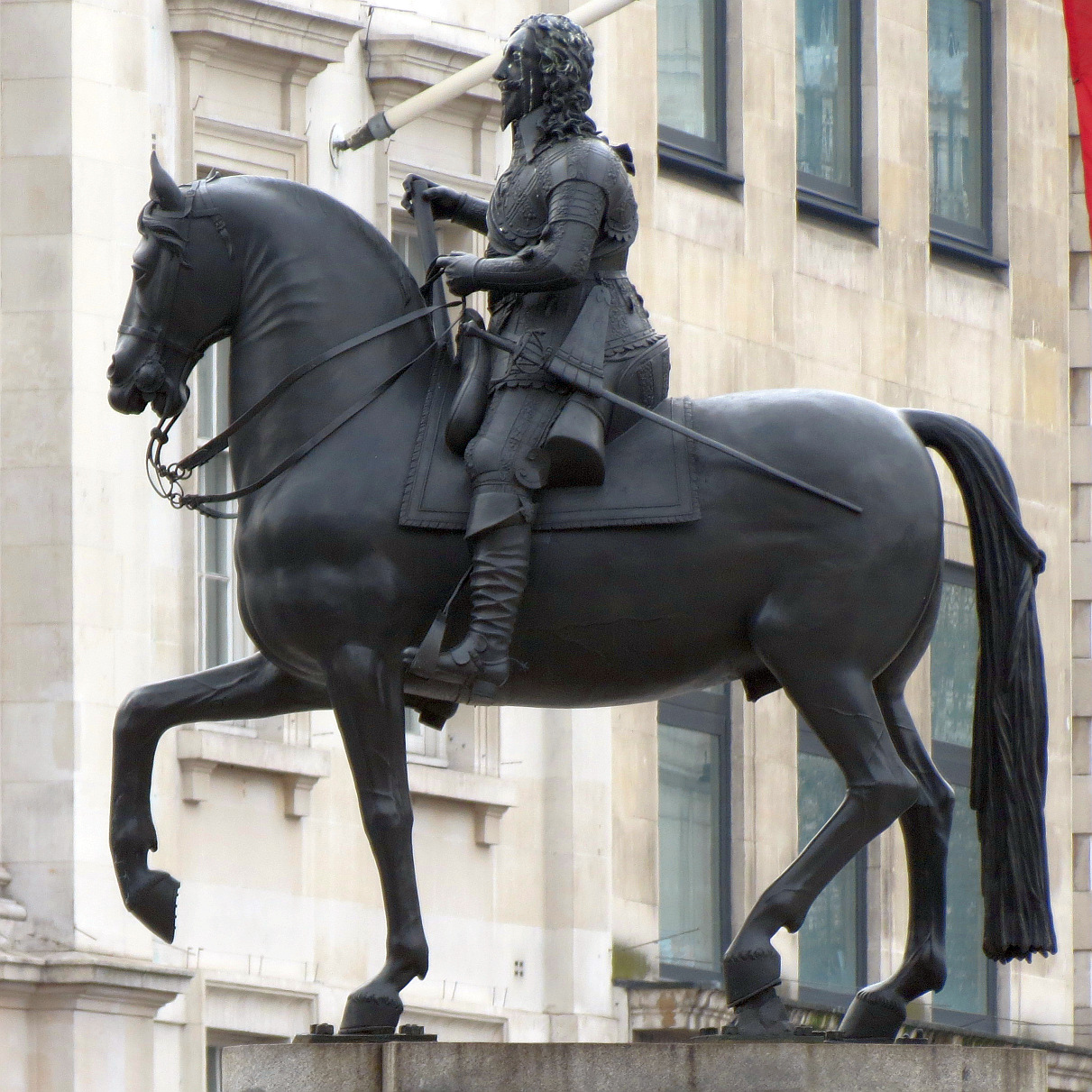
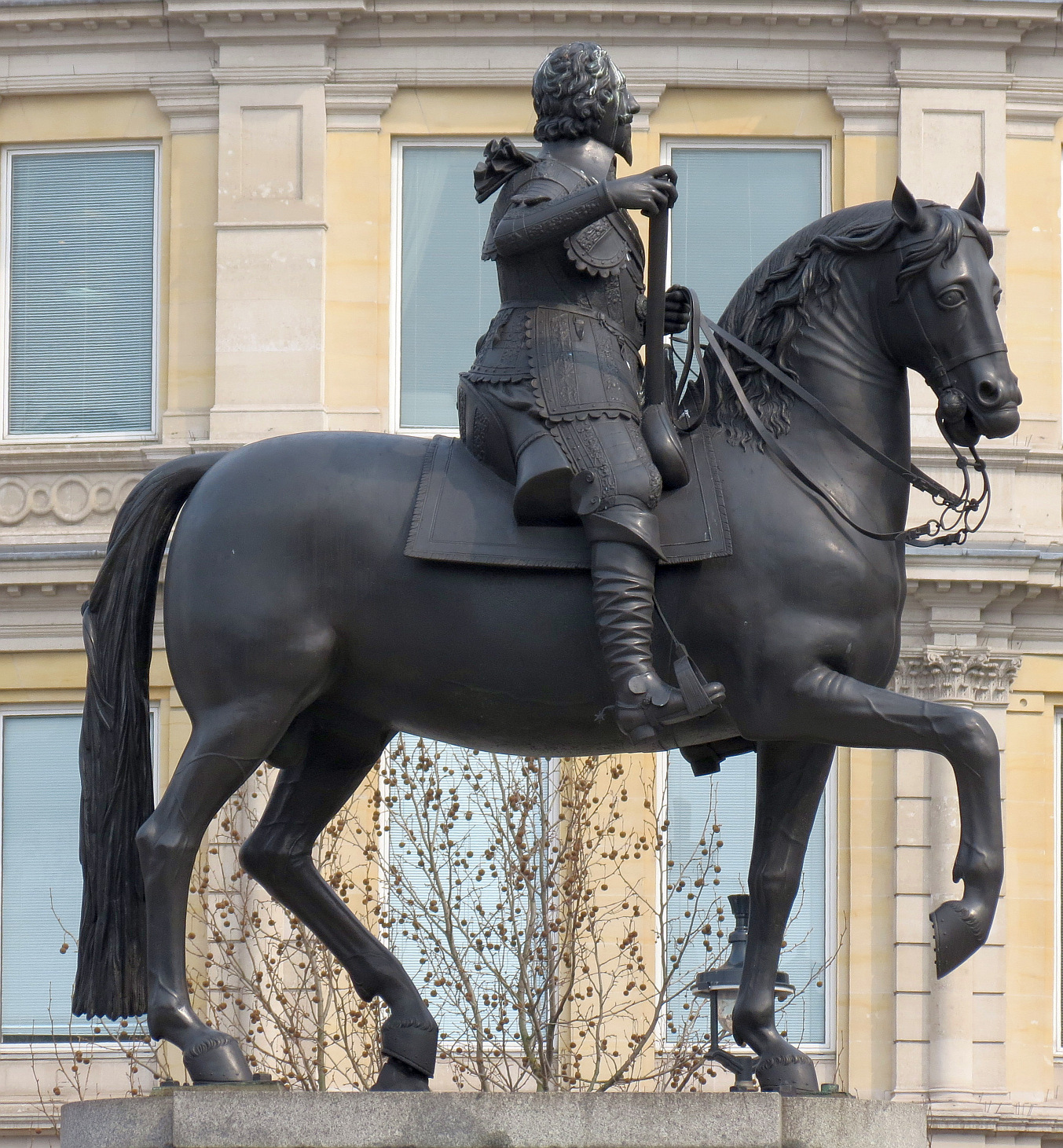
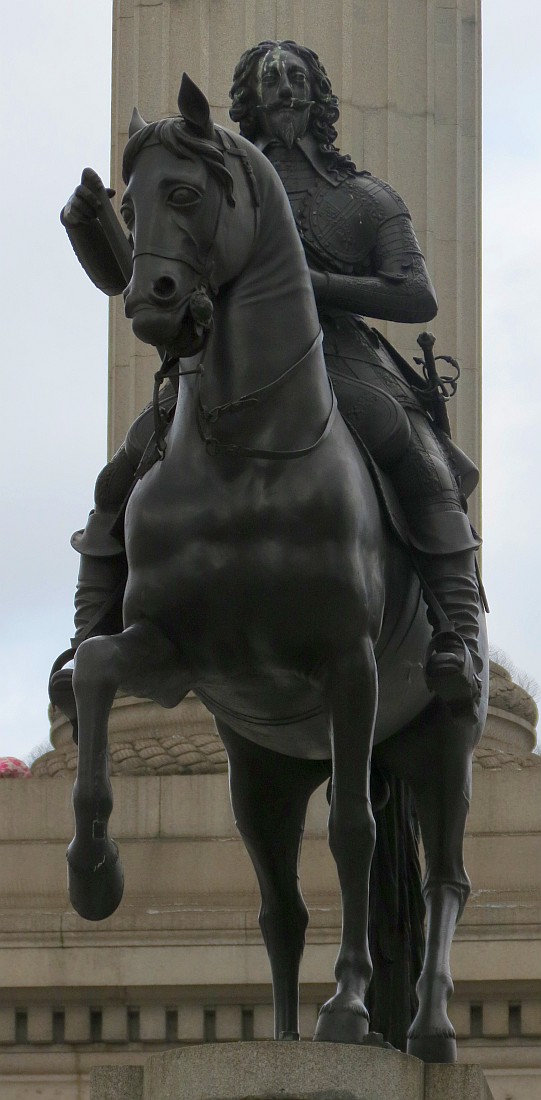
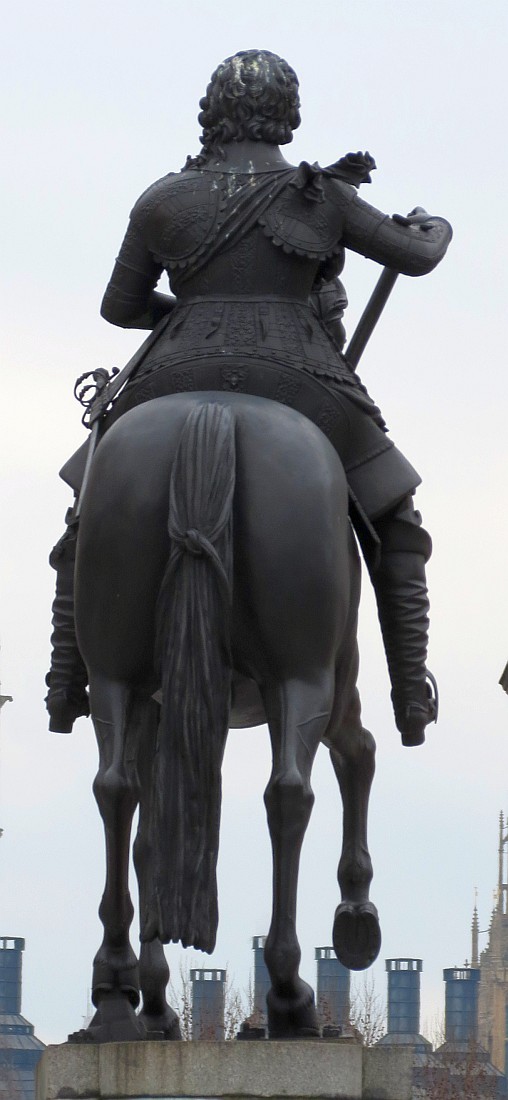
These photographs lifted from http://www.speel.me.uk/draw/drawhorse.htm
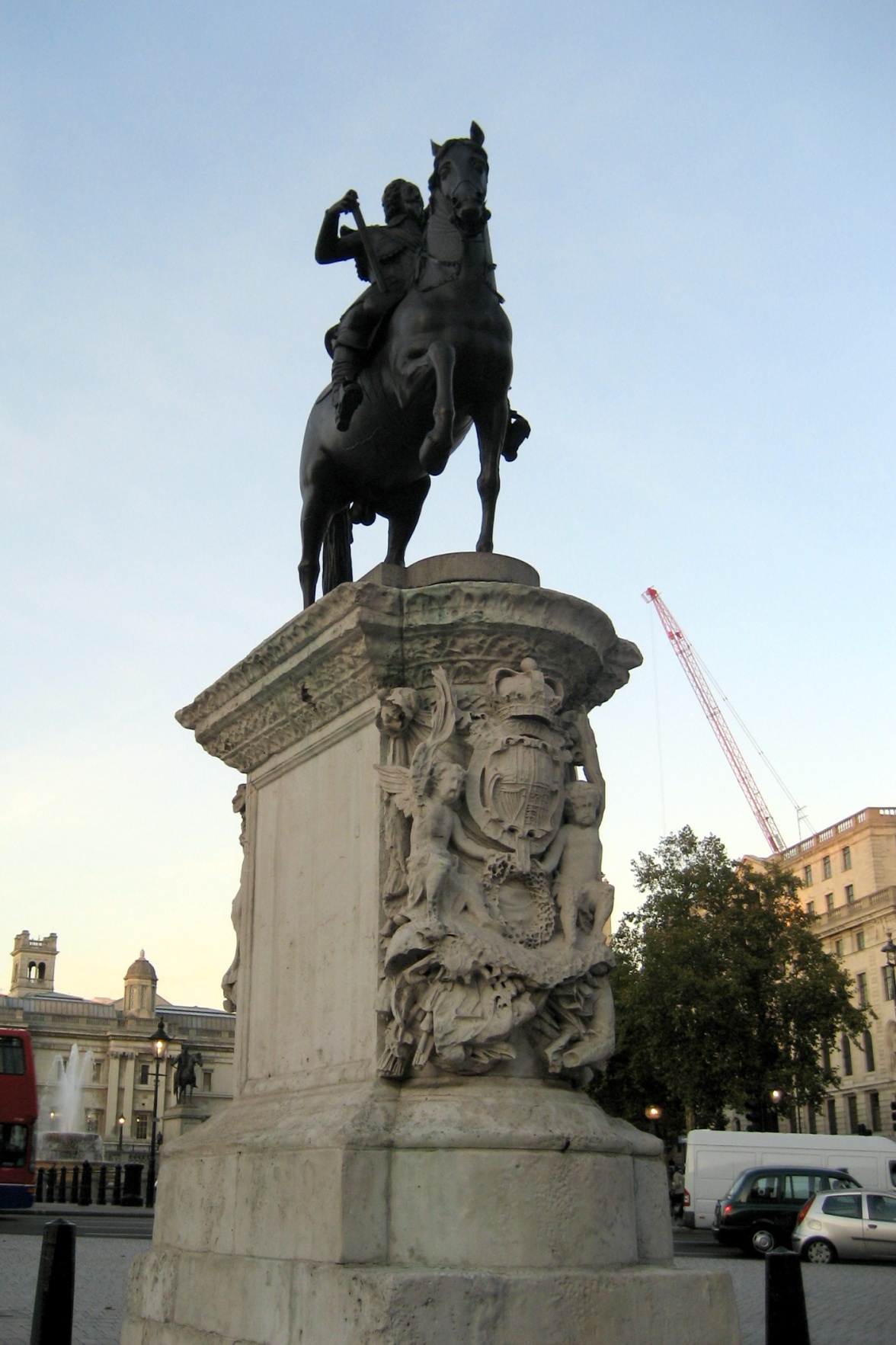
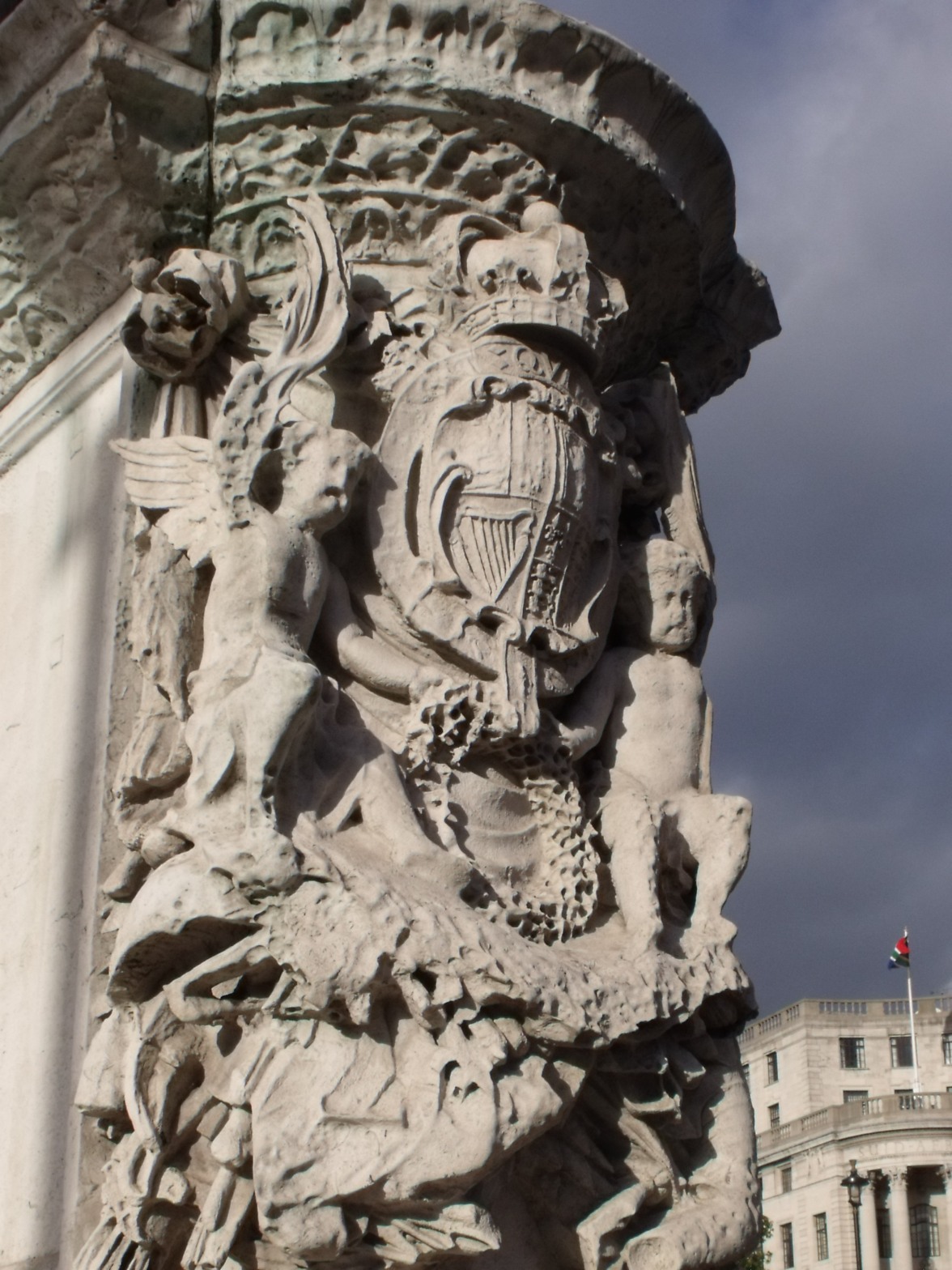
Northumberland House behind
Engraving
Royal Collection

Bronze Equestrian Statue of Charles I (1600 - 49) by Hubert Le Sueur (1580 - 1670).
by
Wenceslaus Hollar (1607 - 1677),
Etching, mid 17th century.pub. Henry Overton.
Plate size - 395 mm x 310 mm.
Etching, mid 17th century.pub. Henry Overton.
Plate size - 395 mm x 310 mm.
Hollar's well-known engraving of the statue must
have been made before its erection at Charing Cross, for the pedestal therein
shown bears no resemblance to the one actually employed. The drawing of the
statue, moreover, is incorrect in many details. The horse is shown with the
left foreleg raised, instead of the right. The right hindleg is also off the
ground, and the King's dress and hair are wrongly drawn. Two other early views
of the statue are given in Morden and Lea's map of 1682 and A Book of the
Prospects of remarkable places in and about the City of London, by the same
authors. In these only the upper half of the pedestal is shown, but it is the
correct pedestal; in other respects the views repeat all the errors of Hollar.
A view of the statue and pedestal complete is given in a drawing by Sutton
Nicholls (Plate 85), which continues the incorrect representation of the
horse's legs. This view shows the iron railings very close to the pedestal.

Anonymous Engraving of Charles I
Lettered
with title at top left, 'D' at lower right and description in lower margin:
"This Portraiture was drawne from the magnigicent Figure cast in brasse by
that most famous Artist Monsieur Le Sueur Ano Dny 1633 exceeding the Proportion
of the life being almost 10 foot high, and with great hazzard charge & care
preserved under ground by John Revet Brasier living at Holborn Conduit at ye
Diall"
Information
from Christine Stevenson (personal communication, July 2012): By 1644 Richard
Weston, Earl of Portland and Charles I's former Lord Treasurer, was dead and
the statue of Charles I which he had commissioned from Le Sueur formed part of
an estate sequestrated that year. As such it was sold off to a consortium of
Covent Garden residents, including the royal Surveyor Edward Carter; they may
have intended it for the piazza, on the pattern of Paris's Place Royale (now
Place des Vosges), which received its equestrian figure of Louis XIII in 1639.
By 1650 the Council of State was trying to establish who owned the Covent Garden
statue. Carter claimed it, and then sold it to the brazier John Revet, who in
1662 testified that he had been ordered 'by some officer at Whitehall ... to
breake ye said statue in peices to ye end That nothing might Remaine in memorie
of his said Majestie', but he had buried it instead.
The story remained well
known. The even better story, that Revet made a fortune selling cutlery handles
supposedly formed out of the royal bronze to royalists and republicans alike,
is unfortunately not true. (Ball, R. M. 'On the statue of King Charles at
Charing Cross', Antiquaries Journal 67 (1987): 97-101, on p. 97.)
Revet lost no
time in advertising the statue after the Restoration, having an engraving of it
made, 'for publique view in Memory of his said Late Majestie'; its letterpress
underlined his 'great hazard charge & care' in defending this memorial.
(Ball 1987, pp. 100, 99, who believed that no copies of the print had
survived.) He then settled with the Portlands, from whom the king then bought
the piece, for £1600, in April 1675. ( The Treasury papers relevant to the
purchase are calendared in CTB 1669-72, p. 1009 (12 January 1672) and CTB
1672-75, pp. 306 (19 April 1675), 732 (30 April), and 745 (26 May).) It was
subsequently erected, with a new plinth, in what is now Trafalgar Square, where
it remains today.
1792
______________________________
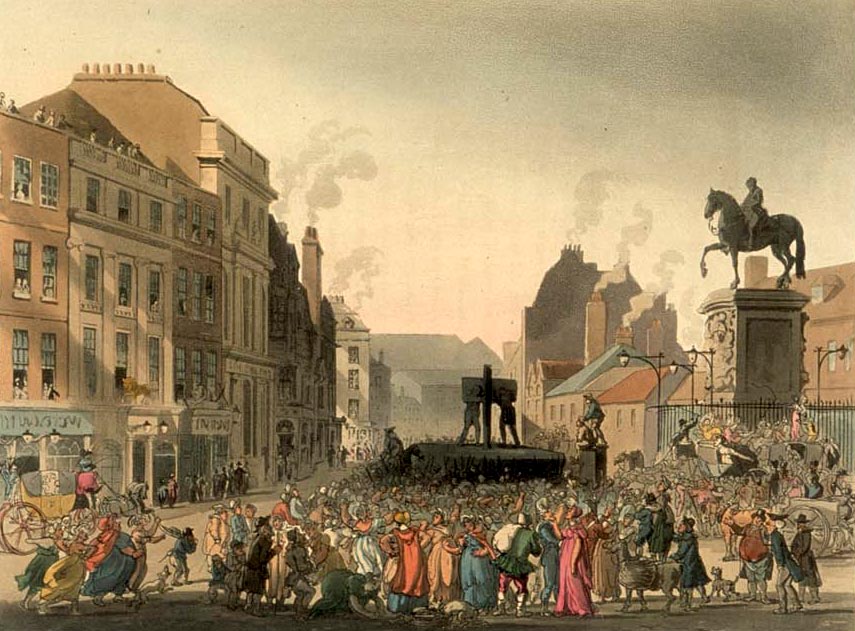
The Pillory Charing Cross. Plate 62 from Micocosm of London, 1809.
Brief reference must be made to the pillory,
which was set close by the statue, as shown by a print by Rowlandson (Plate
117) in 1809. The view is taken looking towards Cockspur Street. The punishment
(inflicted by the populace) differed according to the popularity of the
culprit. Thus, when Defoe was pilloried at Charing Cross in 1703 he received an
ovation. The pillory was hung with garlands and the crowd drank his health. On the
other hand John Middleton, who was pilloried at Charing Cross for perjury in
1723, was so severely handled that he died before he was released.

Hubert le Sueur
after van Dyck
Mezzotint by Jan van Somer
circa 1670 - 1680.
222 x 172 mm.
Previously in the Collection of Michael Rysbrack - Collection mark at bottom right.
______________________________________
Small Equestrian Statue of Charles I (1600 - 49).
poss. 1630's.
Bronze.
33.0 x 27.0 x 11.0 cm. without base.
Gilt-bronze
equestrian statuette of Charles I depicted in full armour, holding a staff in
his right hand. Set on an ebony plinth with bronze foliate borders inset with a
gilt bronze roundel of St.George and Dragon. Related to Hubert Le Sueur's
equestrian statue of Charles I from circa 1633, this is probably the first
bronze reduction of an equestrian portrait of an English sovereign and it has
been suggested that it could be identified with Charles I's 'picture of
horseback upon a black wooden Peddistall belonging to - Sommersett House'
listed in the Van der Doort's inventory from circa 1639.
Provenance
Provenance
Bought
by H.M. Queen Elizabeth The Queen Mother in 1947 (from Collection of Mary, Lady
Millais). Bought by the Prince Regent (Lord Yarmouth) at Squibbs auction 1813.
Possibly belonged to Louis XVI based on design for statue XV in the Palace
Royale Rouen 1776 (never executed).
Night by William Hogarth with the Equestrian Statue of Charles I in the background.
British Museum.

1707.
British Museum

Lettered with title on scroll in sky, and with publication line within image at bottom of statue: "London Sold by Iohn Bowles Print and Map Seller over against Stocks Market", and below at right "Sutton Nicholls delin et sculp.
1725.
British Museum.

Maurer
1740.
British Museum.

Drawing attrib. Samuel Scott
244 x 383 mm
1746
British Museum
______________________________

Drawing attrib. Samuel Scott
244 x 383 mm
1746
British Museum
______________________________

James Green after Samuel Wale
1761
British Museum

1752
British Museum.

Print by Thomas Bowles III after Canaletto.
1753
British Museum

Charing X by Canaletto

Louis Phillipe Boitard
1756
British Museum

c.1770
Engraving James Miller after Giuseppe Canali

engraving by Thomas Medland after James Miller
215 x 273 mm
1795
British Museum
______________________________________

Magazine Illustration
dated in pencil 1784
92 x 180mm
British Museum
see also below.

__________________________________

Thomas Malton 1795
British Museum.

Thomas Malton
1795
British Museum.
Joseph Nickolls (1689 - 1789).
Royal Bank of Scotland
Anon.
Mid 18th Century
Museum of London

John Dean Paul
Museum of London
Canaletto
1752

View in
Charing Cross, with the equestrian statue of Charles I on the right, the Strand
curving away into the distance; a carriage and a cart in the foreground;
illustration from Ackermann's The Repository of Arts, part 26 volume 5. 1811
Etching with hand-colouring
© The Trustees of the British Museum.

Thomas Barber after Thomas Hosmer Shepherd
Steel Engraving
130 x 197 mm.
1828
British Museum

Thomas Shotter Boys
View in
Charing Cross; to the left can be seen the portico of St Martin in the Fields,
beside it si Morley's Hotel and beyond that the corner turret of Nash's West
Strand improvement; on the right is Northumberland House with twin lead-capped
turrets and a central lion; in foreground to right is the equestrian statue of
Charles I with 'T.S.Boys 1841' inscribed on the pedestal, a group of boys sit
below, to the left a water cart laying the summer dust, a hansom cab and a
striking pair of equestrians. 1842 Lithograph
© The
Trustees of the British Museum.

From Roque's Map
1746
________________________________
‘In 1853 the Crystal Palace Company commissioned the formatore
Domenico Brucciani to produce a plaster mould and cast of the equestrian
statue of Charles I by Hubert Le Sueur, which had been cast in bronze in 1633
and installed at Charing Cross by 1675. The reproduction of the bronze statue
and its later portland stone pedestal provided an intriguing public spectacle
as a temporary wooden workshop was built around the sculpture at its location
on a traffic island near Trafalgar Square.
From -
Charing Cross
George Scharfe
1831
British Museum.
Ever since discovering Peter Jackson's book on George Scharfe I have been fascinated by his work.
Here I take the opportunity to post his charming drawings of Charing Cross, showing the equestrian statue of Charles I

Charing Cross
George Scharfe
227 x 324 mm
1825
British Museum
_________________________________________

South end of the pedestal
John Wykham Archer
Watercolour
372 x 266 mm.
c 1850.
British Museum

North Side of the Pedestal
John Wykham Archer
Watercolour
366 x 262 mm
c.1850.
British Museum
________________________________________

Sixpenny Silver Trade Token
19th Century
issued by H Morgan
no size given
British Museum.

One Shilling Silver Trade Token
British Museum













No comments:
Post a Comment